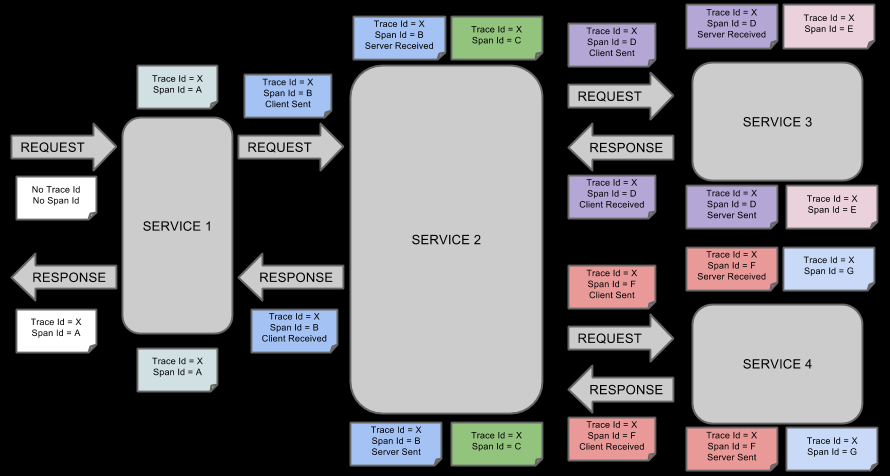Spring Cloud之Finchley版学习(二十四)-Spring Cloud Sleuth入门
经过前文讲述,我们的微服务架构日趋完善,已可使用Spring Cloud构建一个非常健壮的系统!
但假设,你的项目一旦出现问题,如何才能快速定位出来呢?一般项目上要求我们快速定位两种问题:
- 调用发生失败,快速定位出是哪个环节出了问题。是微服务问题,还是网络?
- 调用慢,如何快速找到性能瓶颈?
这正是调用链监控要做的事情。Spring Cloud提供Sleuth来实现调用链监控。
简介
Spring Cloud Sleuth为Spring Cloud提供了分布式跟踪的解决方案,它大量借用了Google Dapper、Twitter Zipkin和Apache HTrace的设计。
TIPS
- Spring Cloud Sleuth的GitHub: https://github.com/spring-cloud/spring-cloud-sleuth
- Dapper论文: https://research.google.com/pubs/pub36356.html
基本概念
(1) Span(跨度):
基本工作单元。span用一个64位的id唯一标识。除ID外,span还包含其他数据,例如描述、时间戳事件、键值对的注解(标签),span ID、span父ID等。
span被启动和停止时,记录了时间信息。初始化span被称为“root span”,该span的id和trace的id相等。
(2) Trace(跟踪):
一组共享“root span”的span组成的树状结构称为trace。trace也用一个64位的ID唯一标识,trace中的所有span都共享该trace的ID。
(3) Annotation(标注):
annotation用来记录事件的存在,其中,核心annotation用来定义请求的开始和结束。
(1) cs(Client Sent 客户端发送):客户端发起一个请求,该annotation描述了span的开始。 (2) sr(Server Received 服务器端接收):服务器端获得请求并准备处理它。如果用sr减去cs时间戳,就能得到网络延迟。 (3) ss(Server Sent 服务器端发送):该annotation表明完成请求处理(当响应发回客户端时)。如果用ss减去sr时间戳,就能得到服务器端处理请求所需的时间。 (4) cr(Client Received 客户端接收):span结束的标识。客户端成功接收到服务器端的响应。如果cr减去cs时间戳,就能得到从客户端发送请求到服务器响应的所需的时间。

快速入门
- 加依赖:
<dependency> <groupId>org.springframework.cloud</groupId> <artifactId>spring-cloud-starter-sleuth</artifactId> </dependency>
加配置:
logging:
level:
root: INFO
org.springframework.cloud.sleuth: DEBUG
其中,配置不是必选的,这里加上日志,只是为了看到更多Sleuth相关的日志。
是不是非常简单!
测试
microservice-provider-user-sleuth http://localhost:8000/users/1
2019-03-13 23:32:46.913 INFO [microservice-provider-user,,,] 14759 --- [nio-8000-exec-1] o.apache.tomcat.util.http.parser.Cookie : A cookie header was received [1551574921,1551708812,1552142696] that contained an invalid cookie. That cookie will be ignored.Note: further occurrences of this error will be logged at DEBUG level. Hibernate: select user0_.id as id1_0_0_, user0_.age as age2_0_0_, user0_.balance as balance3_0_0_, user0_.name as name4_0_0_, user0_.username as username5_0_0_ from user user0_ where user0_.id=? 2019-03-13 23:32:46.975 TRACE [microservice-provider-user,e22f74e62c06104b,e22f74e62c06104b,false] 14759 --- [nio-8000-exec-1] o.h.type.descriptor.sql.BasicBinder : binding parameter [1] as [BIGINT] - [1] 2019-03-13 23:32:46.981 TRACE [microservice-provider-user,e22f74e62c06104b,e22f74e62c06104b,false] 14759 --- [nio-8000-exec-1] o.h.type.descriptor.sql.BasicExtractor : extracted value ([age2_0_0_] : [INTEGER]) - [20] 2019-03-13 23:32:46.982 TRACE [microservice-provider-user,e22f74e62c06104b,e22f74e62c06104b,false] 14759 --- [nio-8000-exec-1] o.h.type.descriptor.sql.BasicExtractor : extracted value ([balance3_0_0_] : [NUMERIC]) - [100.00] 2019-03-13 23:32:46.982 TRACE [microservice-provider-user,e22f74e62c06104b,e22f74e62c06104b,false] 14759 --- [nio-8000-exec-1] o.h.type.descriptor.sql.BasicExtractor : extracted value ([name4_0_0_] : [VARCHAR]) - [张三] 2019-03-13 23:32:46.982 TRACE [microservice-provider-user,e22f74e62c06104b,e22f74e62c06104b,false] 14759 --- [nio-8000-exec-1] o.h.type.descriptor.sql.BasicExtractor : extracted value ([username5_0_0_] : [VARCHAR]) - [account1]
- 从日志可以发现,此时日志多出来类似
[microservice-provider-user,e22f74e62c06104b,e22f74e62c06104b,false]的内容。
经过数据分析,就能实现本文开始提出的两个诉求啦!如何分析呢?且听下回分解。
TIPS
本文的例子本身意义不大,主要是让大家了解下Sleuth的基本概念以及如何整合。实现分布式应用的监控才有意义;另外完善的监控工具一般都会配备一个良好的界面,便于大家才能迅速了解系统的运行情况。这些都是下一节要探索的问题。
配套代码
- GitHub: https://github.com/eacdy/spring-cloud-study/tree/master/2018-Finchley/microservice-provider-user-sleuth
- Gitee: https://gitee.com/itmuch/spring-cloud-study/tree/master/2018-Finchley/microservice-provider-user-sleuth
本文链接 : 跟我学Spring Cloud(Finchley版)-24-Spring Cloud Sleuth入门
- 本文标签: apache Twitter tar Spring cloud 代码 client Master UI CST HTML zip Logging https bug GitHub provider 测试 IO 配置 微服务 App spring ACE git zipkin Google value 服务器 NIO sql Spring Cloud Sleuth CTO http ip 分布式 IDE Select root Service cat Sleuth 时间 src tomcat id 数据 2019 parse
- 版权声明: 本文为互联网转载文章,出处已在文章中说明(部分除外)。如果侵权,请联系本站长删除,谢谢。
- 本文海报: 生成海报一 生成海报二











![[HBLOG]公众号](https://www.liuhaihua.cn/img/qrcode_gzh.jpg)

